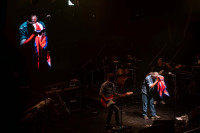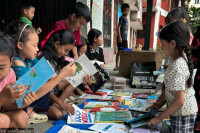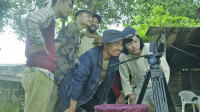Entertainment
Altering course of global art history
The Solo Projects, numbering 17, held pride of place at the Dhaka Art Summit (DAS) held in Bangladesh’s capital city in February this year. Curated by DAS Director, Diana Campbell Betancourt herself, the Solo Projects were either special commissions for DAS or highly acclaimed and already existing works from artists working in South Asia, Europe and the US.
Kurchi Dasgupta
The Solo Projects, numbering 17, held pride of place at the Dhaka Art Summit (DAS) held in Bangladesh’s capital city in February this year. Curated by DAS Director, Diana Campbell Betancourt herself, the Solo Projects were either special commissions for DAS or highly acclaimed and already existing works from artists working in South Asia, Europe and the US.
The Samdani Art Foundation supports and makes possible the DAS and allows it to function as a mainstream alternative to both the art fair and biennale formats. The Foundation’s focus is on research and documentation into the region’s, especially Bangladesh’s, art history as well as promoting unusual yet exciting artistic impulses that connect to South Asian concerns. The fact that DAS does not act as a collecting arm for the Samdani Art Foundation makes it possible for them to commission works that do not necessarily fit into the Foundation’s collecting agenda, nor is restricted to the new. A happy situation that allows for works like Tino Sehgal’s Anne Lee (2011) to be showcased at the event.
We ‘witnessed’ Ann Lee in an enclosed, carpeted space downstairs, on the ground floor of the Bangladesh Shilpakala Academy. True to his oeuvre, Sehgal had ensured that Ann Lee was neither photographed nor documented in any way other than in the viewers’ memory—a restriction that immediately excites the imagination for ours is an age in which documentation overkill surrounds almost every exhibited piece of art. Ann Lee, lasting approximately five minutes, was haunting.
Your first encounter with Ann is usually abrupt, for you will have no doubt walked midway into yet another ‘constructed situation’ that is Sehgal’s hallmark, and was confronted by one of the five girls in their early teens, who delivered the piece at DAS. And caught her verbalising the process of being transformed from a cheap Japanese Manga animation character into a 3 dimensional being, and then 4 dimensional, for she has now entered the flow of real time. She was envisioned as a piece of contemporary art by the artist, gave out Ann Lee in her halting, mechanical speech that resembled an automaton’s and went on to challenge the viewers with gut wrenching queries into the nature of Being. Ann Lee is a work that can be easily overlooked in the bustle of a Summit, yet it was the only piece of art that demanded a revisit from me the next day. Interestingly, Sehgal was bringing to imaginary life a Manga character destined for animated obscurity and eventual annihilation had it not been ‘saved’ from its fate by an artist duo that bought it from its commercial creators and offered it to other contemporary artists for creative production.
The same philosophical intensity charged the works of Bangladesh’s Mustafa Zaman. Quiet introspection pervaded the 20 digital prints that represented his new series of altered photographs, Lost Memory Eternalised (2016). Globs of honey with dead ants floating in it have been poured onto images of iconic moments/individuals from Bangla cultural history and re-photographed and printed again to arrive at a supra-linguistic comment on the immateriality of history, memory and time. In the artist’s own words, ‘each image, though not fully shorn off their evidentiary value, has been overlaid with a symbolic action and was thus transmuted from mere observed-images to felt-images after being treated with a layer of honey in which dead ants are floating. With the intrusion of the additional substance the historicity of the images is destabilised. They now invite touching and enforce a renewal of vision. By pushing the image to the limits of its semantic structure the project seeks to reengage the viewers on a hybrid plain where the sense of the past, present and future is rendered irrelevant.’
Another Bangladeshi artist Ayesha Sultana’s multi-object installation, A Space Between Things (2016) tiptoed around a similar enquiry into the nature of reality, particularly landscapes, through 10 separate pieces created from found and reclaimed materials installed on, above and around a floor, whose loose tiles rattled and knocked against each other with every step we took. With it she has characteristically explored the layered notion of landscape in the context of built, urban architecture. The duality of the material and immaterial are central to her exploration, but the work came across as a little too insular and evocative in the Modernist sense and despite an exciting juxtaposition of textures and rhythms, failed to inspire much intellectual engagement. The insularity of the piece was reflected in its limited accessibility—about only a dozen viewers were allowed in at a time. Exclusion was also central to the Burmese artist Po Po’s VIP Project in which he had documented his interventions in Yangon and Dhaka through digital prints and video. VIP signs were spread out across the two cities—at bus stops, busy roads, etc—and people’s habit-born reactions to it provide a succinct comment on South Asia’s exclusionary political and cultural contexts.
Shakuntala Kulkarni’s set of five body armours woven from cane following traditional methods wittily spoke of violence and trauma without receding into the passé. “The body of the citizen, especially the female citizen, faces pervasive threat as we negotiate an epoch of escalating terror and violence. No longer confined to declared warfronts and conflict zones, these forces have infiltrated both public and intimate spaces, civic and domestic contexts. The embodied self can be insulted, subjugated, incarcerated, curbed by religious decree, dictatorial whim or popular sentiment. It can be deprived of the rights of mobility and expression… An armoured body can extend its capabilities through the mailed fist, the spiked helmet, the radiation-proof bodysuit, or heightened fight/flight reflexes. But the body pays for this protection with its freedom. The armour becomes a cage. The self becomes prosthetic: protected by, yet trapped within, an exoskeleton,” writes Ranjit Hoskote in Of Bodies, Armours and Cages (Exhibition Catalogue, Mumbai, Chemould Prescott Road, 2013). Placed in a nearby enclosure was USA-born Lynda Benglis’s body of work that supposedly reflects her engagement with the Indian subcontinent. Fourteen new cast paper sculptures constructed out of handmade paper, chicken wire,
acrylic paint and glitter conveyed her preoccupation with ‘proprioception’ that can be summerised as ‘the unconscious perception of movement and spatial orientation arising from stimuli within the body itself’ and which she sees as experiments with the body’s perceptive skills. Though aesthetically beautiful, the glittery works merely materialised a subjective two-dimensionality and failed to draw us into the sensory world it declared open.
I end here with a nod to Dayanita Singh’s very well travelled book of photographs cum art object called the Museum of Chance (2014) without which no South Asian art event is complete anymore, I guess. As expected, the photographs are memorable and exquisitely produced, and throw open windows into symptomatic moments from our regional reality. A reality that Dhaka Art Summit is no doubt keenly interested in bringing to the international art world’s notice, and perhaps even hoping that such windows will help alter the course of global art history over the next few decades.
...to be continued...




 13.12°C Kathmandu
13.12°C Kathmandu










